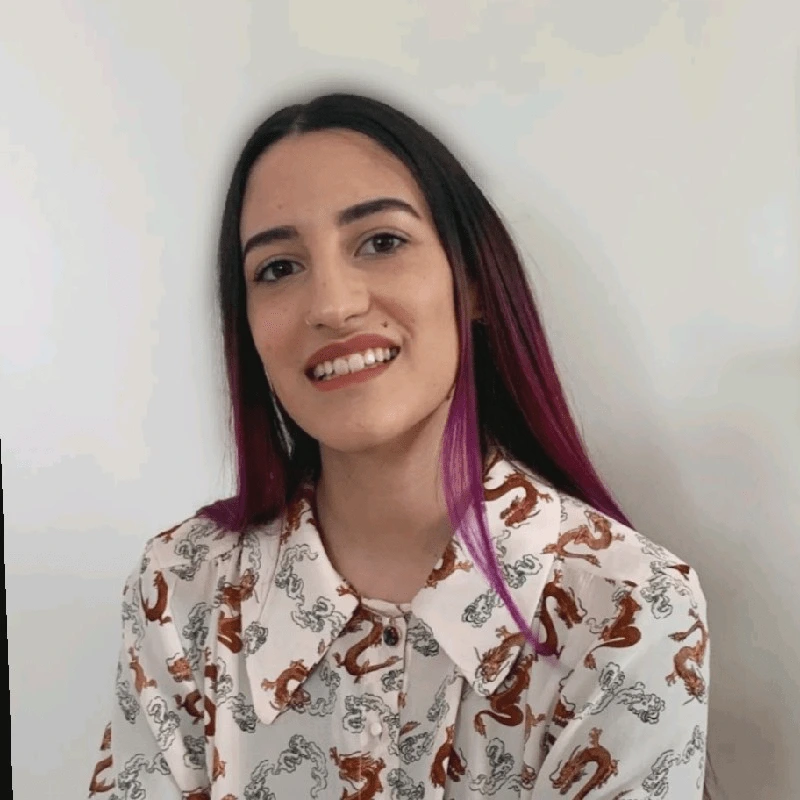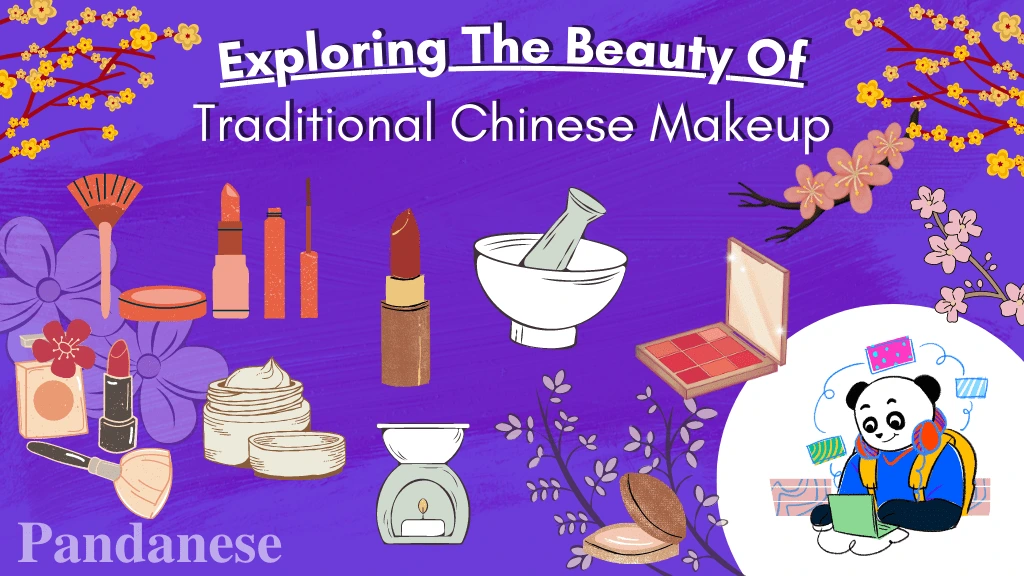
Exploring The Beauty Of Traditional Chinese Makeup
Traditional Chinese makeup has a long and fascinating history, spanning centuries and encompassing various styles and techniques. It's something so rich in symbolic power that it's one of the first images coming to mind when thinking about China.
In this article, we will look at the history of traditional Chinese makeup, learn about how Chinese makeup was made in ancient times, and learn about the legends that originated some traditional makeup styles.
Chinese makeup history
Let's explore the history of Chinese makeup, the cultural significance and symbolism behind various makeup styles, and how they have changed and evolved throughout Chinese history.
Ancient Chinese makeup
The earliest records of Chinese makeup can be traced back to the Shang Dynasty (1600–1046 BC). During this time, makeup was used to signify social status. The nobility wore elaborate makeup to distinguish themselves from the common people. It was also believed that makeup had healing properties and could ward off evil spirits.
Over time, makeup in China became more refined and sophisticated. Chu Ci's poem "Da Zhao" mentions how beautiful women of the time did their makeup. It shows that as early as pre-Qin times, women began to wear makeup, painting their faces, eyebrows, and lips. In his historical drama "Qu Yuan," the famous historian Guo Moruo spoke of a girl named Chan Juan for Qu Yuan, who wore a bag of scented powder to retouch her makeup at any time.
Jin dynasty makeup
During the Jin dynasty (266–420 AD), court ladies liked to draw geometric designs on their foreheads. These broad and geometric designs reflected the tumultuous time in China.

"Lady of Plum Blossoms" by Yuan Ren, Zhihu
Northern and Southern dynasties makeup
In this period (420–589 AD), ladies were heavily influenced by Buddhist statues and murals, resulting in a very minimalistic yet striking design created by adding four dots across the face.
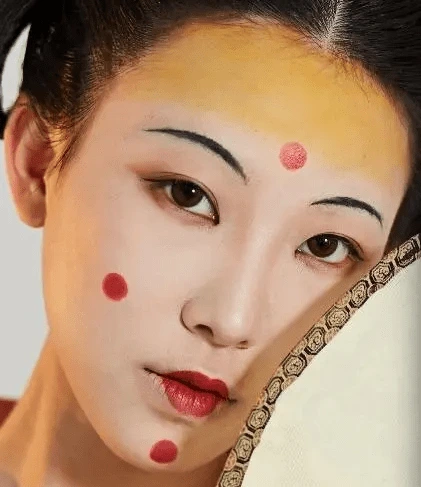
Northern and Southern dynasties of Chinese makeup, Baidu
Tang dynasty makeup
During the Tang dynasty (613–907 AD), empress Wu Zetian encouraged creativity in makeup. There were dozens of popular eyebrow shapes. Curved, thin eyebrows, which resembled a willow leaf or a moon, were also fashionable because they symbolized elegance.
During the Tang dynasty, huadian, a decorative element located on the forehead between the eyebrows that, according to the legend, originated during the Northern and Southern dynasties, also became very popular, and various designs were created.
Eyebrows were painted in many different shapes during the Tang dynasty.

Painted eyebrow trends in Tang dynasty, Deviantart
During the high Tang dynasty, makeup styles shifted towards a soft and romantic look, with the court ladies preferring ornate floral designs.
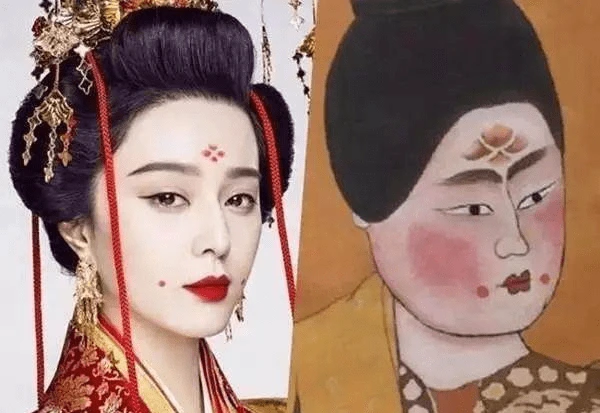
Tang dynasty, makeup styles. Right: in real life. Left: in a painting. iNews
Song dynasty makeup
In the Song dynasty (960–1279 AD), makeup became even more elaborate. Women used a wide range of cosmetics to create intricate and detailed looks. For example, it was common for women to put white powder on the forehead, nose, and chin, which was called 三白妆 sānbáizhuāng, literally "three whites makeup," to bring light to the center of the face.

Vintage image of Chinese women with 三白妆 for a more pale complexion, Pinterest
Eyebrows had a delicate shape.
During the Song Dynasty, the first nail polishes were also created, and the most used color was red. Painted nails in the Song dynasty was not only considered a symbol of beauty but also a status symbol.
The main element of the Song dynasty makeup style was pearls, which were applied on temples, the forehead, or the cheeks. This style was very popular with empresses and aristocrats.

Old Chinese image depicting high class women with Song dynasty makeup, Baidu
Ming dynasty makeup
The Ming women's makeup style was more more natural-looking, with a focus on enhancing natural beauty rather than creating artificial looks. Women during this time would often apply a light dusting of rice powder to their faces to give their skin a smooth, matte finish.
Qing dynasty makeup
In the Qing dynasty (1644–1912 AD), makeup once again became more elaborate and theatrical, with women using bright colors and bold patterns to create dramatic looks. During this time, applying makeup to the cheeks became popular.
As you can see, Chinese makeup of changed and evolved over time. Makeup routines tend to be the same throughout each dynasty, but it varies on what was put on and the style.
How Chinese makeup was done through the Chinese dynasties, Off the Great WallChinese modern aesthetics
In modern times, with the spread of Western culture to the east, a series of changes have taken place in the cosmetics used by Chinese women. Although Chinese beauty standards are increasingly influenced by western style, some peculiar elements can still be found in Chinese women's makeup style, such as a predominance of white makeup and a tendency not to wear heavy makeup.
In general, Chinese women typically go for a more innocent and less sexy vibe compared to western standards.
See also: The 4 Key Concepts of Chinese Aesthetic in Chinese Art
The symbolism and significance of traditional Chinese makeup
In traditional Chinese culture, makeup was more than just a tool for enhancing one's appearance. It was also a way to communicate social status and cultural identity.
For example, women who painted their faces white embodied the ideal of feminine beauty and purity since white was associated with the moon, a symbol of femininity and purity in Chinese culture.
The white face makeup style was popularized during the Tang dynasty and continued to be worn throughout the Song dynasty. This style involved painting the entire face white with a mixture of rice flour and lead powder. The white face was seen as a symbol of beauty and purity, often accompanied by blackened eyebrows and red lips.
A pale complexion is still considered the beauty standard in China, where people avoid tanning and always make sure to apply skincare. The origin of this beauty standard is linked to social status: upper-class members had pale skin because they didn't have to work outside, under the sun.
How was makeup made in ancient China?
As for many Asian civilizations, a lot of natural materials were used. For example, the main ingredients were flowers, plants, animal fats, and spices.
Face foundation or powder (粉 fén) was made by grinding rice into a fine powder that was then exposed to the sun. For the rich aristocrats, another kind of face powder was made from lead, which, although toxic, was praised for its skin-whitening properties.
Blush (脸红 liǎnhóng) was used to color the cheeks, lips, and eyes. It was made from the naturally extracted juice of leaves from red and blue flowers. It could also be mixed with fats or oils for a more dense texture.
Chinese women have always paid great attention to their eyebrows, and traditional Chinese makeup includes various eyebrow styles. A type of eyebrow product was 黛 dài, a blackish grinded mineral to draw in the eyebrows with a fine brush.
Lipstick (唇脂 chúnzhī) was made using vermillion, rose petals, and peonies. There are many different types of lip styles that were used throughout ancient China.
Click below to watch a quick video of the different lip styles throughout the different Chinese dynasties: Lipstick similarities and differences in Chinese dynasties by Mochi Hanfu.
3 traditional Chinese makeup elements and their origins
There are three traditional makeup elements with significant influence.
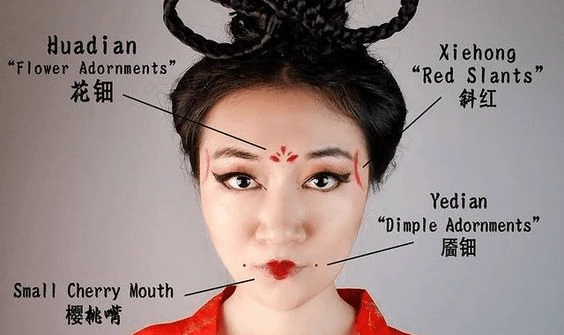
Breakdown of traditional makeup elements, xiranjayzhao
Let's break them dpwn and see their origins.
1. Huādiàn 花钿 (plum blossom makeup)
There's a legend about how the plum blossom makeup became popular in ancient China.
During the northern and southern dynasties, there was a beautiful princess called Shouyang. She loved plum blossoms and admired them in the palace gardens. She got tired, so she fell asleep in the garden.
As the princess closed her eyes, a plum blossom fell onto her forehead, and when she woke up, it left a mark that looked like a flower. No matter how hard she tried to wash it off, it wouldn't come off until three days later. By then, all the ladies in the palace were jealous of her beauty, and they tried to copy it.
Huadian makeup thus became a trend: over centuries, ladies would get creative and draw new designs in the shapes of animals, stars, the moon, water droplets, and flowers. They would even paste butterfly or dragonfly wings to their foreheads.

Huadian-makeup look, Jessica Chen
2. Yèdiàn 靥钿
The story behind this trend that was popular during the Tang Dynasty comes from the three kingdoms period when the crown prince accidentally hit her favorite concubine with a crystal scepter. Her face started to bleed, and even after she was healed, the scars didn't fade. These scars made her even more beautiful to the prince, and other concubines began to replicate this style.

Yèdiàn 靥钿 make up on the dimple, 愛麗話五千
3. Xiéhóng 斜红
This makeup style is believed to have originated during the three kingdoms period.
According to the legend, a concubine was on her way to see the emperor on a summer evening. It was dark, and she could not see a crystal screen in the middle of the room. She bumped into it, got hurt, and got a scar. The emperor was fascinated by her beauty and compared her wound to dawn.

Red slant makeup or Xiéhóng 斜红, Sina
For a more in-depth look into these traditional elements of Chinese makeup, watch the video below:
Traditional Chinese Makeup explained by Five Thousand YearsIn closing
Chinese beauty standards have changed significantly over time. Even though modern trends come and go, historical and traditional Chinese makeup is an established pride in Chinese culture.
Whether you're passionate about makeup or want to learn more about Chinese culture, I hope you enjoyed this journey of traditional Chinese makeup styles.
Elisa Felici has been studying Chinese since 2014. She started her language-learning journey at Italian universities and lived in Beijing while attending Beijing’s Confucius Institute. Elisa passed HSK 4 and 5 and finally, in 2020, HSK 6. She now has a Master’s degree in translation and interpreting and has experience not only as a language learner but also as a Chinese teacher and translator.
The easiest way to learn Chinese & build vocabulary

